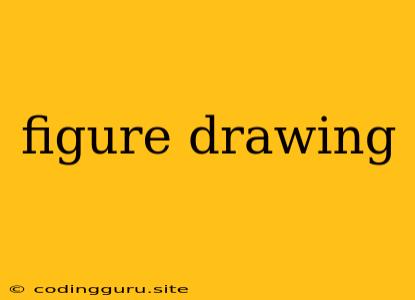The Art of Figure Drawing: A Comprehensive Guide
Figure drawing, the art of capturing the human form on paper, is a fundamental skill for any aspiring artist. It's a demanding but rewarding endeavor that deepens your understanding of anatomy, proportion, and movement. Whether you're aiming to become a professional illustrator, a comic book artist, or simply want to improve your observational skills, mastering figure drawing is an essential step.
Why is Figure Drawing so Important?
Figure drawing is more than just sketching a human body. It's about understanding the underlying structure, the subtle nuances of form, and the dynamic energy that defines our physical presence. Here's why it's crucial:
- Develops Anatomical Awareness: By focusing on the skeleton, muscles, and the way they interact, you gain a deeper understanding of the human form. This knowledge translates into more accurate and realistic depictions in any style of art.
- Enhances Proportion and Perspective: Mastering figure drawing forces you to confront the challenges of scale and perspective. You learn how to accurately represent the body's proportions and how they change with different angles and poses.
- Improves Composition and Movement: Observing the human form in motion helps you understand the flow of lines, the weight distribution, and the overall dynamism of the body. This knowledge improves your ability to create dynamic and captivating compositions.
- Sharpens Your Observational Skills: Figure drawing demands close observation. You learn to break down complex forms into simpler shapes, identify key features, and translate your perception onto paper.
Getting Started with Figure Drawing
Here are some essential tips for beginners to embark on their figure drawing journey:
- Gather Your Supplies: Start with a basic sketching pencil (HB or 2B), a drawing pad, and an eraser. As you progress, you can experiment with different tools, such as charcoal, colored pencils, or even digital drawing software.
- Find a Reference: Start with simple reference images, like photographs or illustrations. You can also use life models, but it's advisable to begin with simple poses and gradually move towards more complex ones.
- Start with the Basics: Focus on capturing the essential shapes and proportions first. Don't get bogged down in details. Use simple lines to outline the body, and gradually add more detail as you progress.
- Practice Regularly: Consistency is key. Set aside time each day or week for figure drawing. The more you practice, the more comfortable you'll become with capturing the human form.
- Study Anatomy: Understanding the underlying structure of the body is essential for accurate figure drawing. Invest in anatomy books or online resources to learn about the skeleton, muscles, and how they affect the form.
Common Mistakes in Figure Drawing
Even experienced artists make mistakes in figure drawing. Recognizing common pitfalls can help you avoid them:
- Ignoring Proportions: Accurately representing the human form requires careful attention to proportions. Make sure to understand the key ratios of the body, such as the head-to-torso ratio or the length of the limbs.
- Failing to Use Reference: Don't rely solely on memory. Always use a reference image or live model to ensure accuracy in your drawings.
- Neglecting the Skeleton: The skeleton provides the framework for the body. Be mindful of its structure and how it influences the overall form.
- Skipping Gesture Drawing: Gesture drawing is a quick, dynamic form of sketching that captures the movement and flow of the body. Don't neglect this crucial step as it builds a foundation for more detailed drawings.
- Over-Focusing on Details: Start with the big shapes and proportions. Add details gradually, as you gain confidence in your drawing.
Tips for Improving Your Figure Drawing Skills
- Break it Down: Instead of trying to draw the entire figure at once, focus on individual body parts. Start with the head, then the torso, then the limbs.
- Use Construction Lines: Construction lines are simple lines that help you establish the basic proportions and structure of the figure. They act as a guide for placing key features and ensuring accuracy.
- Practice Gesture Drawing: Gesture drawing is a great way to loosen up your style and capture the essence of movement. Use quick, loose strokes to capture the overall shape and flow of the figure.
- Study Master Artists: Look at the work of famous figure drawing artists like Michelangelo, Leonardo da Vinci, or Gustav Klimt. Analyze their techniques, their use of line and form, and their approach to anatomy.
- Experiment with Different Styles: Don't be afraid to try different styles of figure drawing. Explore realism, caricature, manga, or abstract styles to expand your artistic vocabulary.
Conclusion
Figure drawing is a journey of continuous learning and improvement. Embrace the challenges, be persistent in your practice, and never stop exploring the endless possibilities of capturing the human form. The rewards of figure drawing go beyond technical proficiency; it fosters a deeper understanding of the beauty, power, and complexity of the human body.
